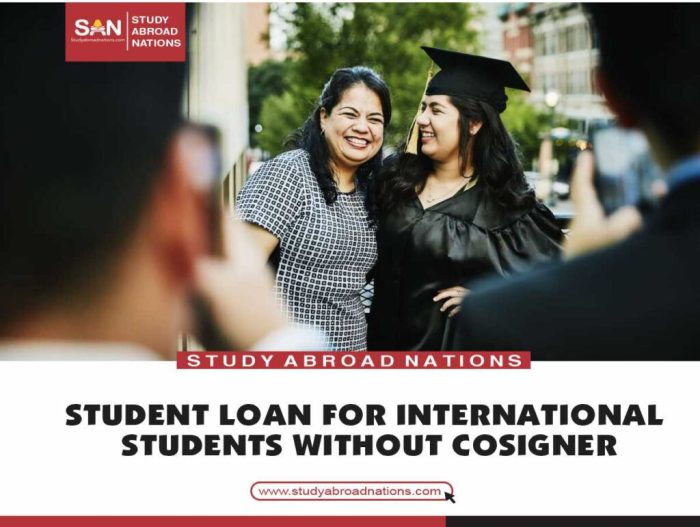
Navigating the world of student loans can be daunting, especially when the prospect of finding a cosigner seems impossible. Securing funding for higher education without a cosigner requires careful planning and understanding of eligibility requirements. This guide explores various options available to students, focusing on the criteria needed to qualify for loans, the different types of loans available, and strategies for increasing your chances of approval.
We’ll delve into the specifics of credit scores, income verification, and the comparison of eligibility across various lenders. Understanding the nuances of federal and private loans, their associated interest rates, and repayment terms is crucial for making informed decisions. We will also cover practical steps to improve your creditworthiness and manage your loan repayment effectively, minimizing potential risks and maximizing your chances of financial success.
Eligibility Requirements for Student Loans Without a Cosigner

Securing a student loan without a cosigner often presents a higher bar for applicants, as lenders assume a greater level of risk. Eligibility hinges primarily on demonstrating a strong credit history and sufficient income to comfortably manage loan repayments. Let’s delve into the specifics of these requirements.
Credit Score Requirements
Lenders typically require significantly higher credit scores for applicants seeking loans without a cosigner. A score below 670 is generally considered subprime, making it very difficult to qualify. While the exact minimum score varies among lenders, most will expect a score in the good to excellent range (700 or higher) to approve an application. A higher credit score often translates to better interest rates and more favorable loan terms. This reflects the reduced risk perceived by the lender.
Income Verification Processes
Income verification is a crucial aspect of the application process for cosigner-less loans. Lenders need assurance that the applicant has the financial capacity to repay the loan. This typically involves providing documentation such as tax returns, pay stubs, bank statements, or employment verification letters. The lender will review this information to assess the applicant’s income stability and debt-to-income ratio (DTI). A low DTI, indicating a smaller portion of income dedicated to debt payments, improves the chances of approval. Self-employment may require more extensive documentation to verify income.
Comparison of Eligibility Criteria Across Lenders
Eligibility criteria for cosigner-less student loans can differ substantially between lenders. Some may have stricter requirements regarding credit scores, while others may place more emphasis on income stability and the type of degree pursued. It’s essential to research various lenders to find the most suitable option based on individual circumstances. Factors like the length of credit history and the presence of any negative marks on the credit report can also influence eligibility.
Eligibility Criteria Comparison Table
| Lender | Minimum Credit Score | Minimum Income Requirement | Other Eligibility Factors |
|---|---|---|---|
| Lender A | 700 | Sufficient to cover living expenses and loan payments | Stable employment history, low DTI |
| Lender B | 680 | Demonstrable ability to repay loan based on income and expenses | Strong credit history, limited negative marks |
| Lender C | 720 | Proof of income for at least two years | Favorable debt-to-income ratio, specific degree programs may be prioritized |
Types of Student Loans Available Without a Cosigner

Securing a student loan without a cosigner can be challenging, but several options exist for eligible students. Understanding the distinctions between federal and private loans, along with their respective advantages and disadvantages, is crucial for making an informed borrowing decision. This section details the various loan types available, highlighting key aspects like interest rates, repayment terms, and eligibility criteria.
Federal Student Loans Without a Cosigner
Federal student loans are generally preferred due to their borrower protections and often more favorable repayment terms. However, not all federal loan programs eliminate the need for a cosigner. The primary federal loan option that frequently doesn’t require a cosigner is the Direct Subsidized and Unsubsidized Loans. Eligibility is based primarily on financial need (Subsidized) and enrollment status (Unsubsidized), with credit history playing a less significant role than with private loans. These loans offer fixed interest rates, which are set annually by the government, and typically provide more flexible repayment plans compared to private loans. However, the amount you can borrow is capped based on your year in school and dependency status.
Private Student Loans Without a Cosigner
Private student loans, offered by banks and credit unions, often require a cosigner to mitigate risk for the lender. However, some lenders may offer loans without a cosigner to students with strong credit scores and a demonstrable history of financial responsibility. These loans are generally more difficult to obtain without a cosigner due to the higher risk perceived by lenders. Interest rates tend to be variable, potentially fluctuating throughout the loan term, leading to unpredictable repayment amounts. Repayment terms can also be less flexible than those offered on federal loans. Moreover, private student loans typically lack the same borrower protections as federal loans.
Comparison of Cosigner-Less Loan Products
The following table compares three hypothetical cosigner-less loan products to illustrate the differences in interest rates and repayment options. Remember that actual rates and terms will vary based on individual creditworthiness and the lender’s current offerings. It’s crucial to shop around and compare multiple lenders before committing to a loan.
| Loan Provider | Interest Rate (Example) | Repayment Term (Example) | Eligibility Requirements (Example) |
|---|---|---|---|
| Federal Direct Unsubsidized Loan | 4.5% fixed (example rate, subject to change) | 10-20 years (standard repayment) | Enrollment in an eligible degree program |
| Private Lender A | 6.0% variable (example rate, subject to change) | 5-15 years (variable options) | High credit score (e.g., 700+), strong financial history |
| Private Lender B | 7.2% fixed (example rate, subject to change) | 10 years (fixed term) | High credit score (e.g., 720+), demonstrated income |
Strategies for Improving Loan Approval Odds Without a Cosigner
Securing a student loan without a cosigner can be challenging, but by proactively improving your financial standing, you significantly increase your chances of approval. Lenders assess your creditworthiness based on several factors, and demonstrating financial responsibility strengthens your application. This involves building a positive credit history and maintaining a strong financial profile.
Improving Credit Scores to Qualify for a Loan
A higher credit score is a crucial factor in loan approval. Lenders view a good credit score as an indicator of your ability to manage debt responsibly. Improving your credit score requires consistent effort and mindful financial habits. Even small improvements can make a noticeable difference in your loan application outcome. For instance, a score increase from 650 to 700 can significantly enhance your eligibility.
Impact of a Strong Financial History on Loan Application Success
A strong financial history, encompassing responsible credit card usage, timely bill payments, and a low debt-to-income ratio, significantly increases the likelihood of loan approval without a cosigner. Lenders see this as a testament to your financial reliability and reduces their perceived risk. Conversely, a history of missed payments or high debt levels can negatively impact your application. A consistent record of responsible financial behavior demonstrates your commitment to repayment, making you a more attractive borrower.
Building a Positive Credit History for Students
Building a positive credit history as a student may seem daunting, but it’s achievable through several steps. Starting early is key. Consider becoming an authorized user on a parent or trusted family member’s credit card with a good payment history. This allows you to benefit from their positive credit activity, indirectly improving your credit score. Another strategy is obtaining a secured credit card, which requires a security deposit, reducing the lender’s risk. Responsible usage, paying bills on time, and keeping credit utilization low are essential.
Step-by-Step Guide to Improve Credit Scores Within a Year
Improving your credit score within a year requires dedication and consistent effort. This plan Artikels specific actions and timelines to achieve noticeable progress.
- Months 1-3: Assess and Correct Errors. Obtain a free credit report from AnnualCreditReport.com. Review it thoroughly for inaccuracies and dispute any errors with the respective credit bureaus. This foundational step ensures a clean credit slate to build upon.
- Months 3-6: Establish Credit. Apply for a secured credit card and use it responsibly. Keep your credit utilization below 30% (the amount of credit used relative to your total credit limit). Make all payments on time, and ideally, pay off the balance in full each month. This demonstrates responsible credit management.
- Months 6-9: Monitor and Maintain. Regularly check your credit report (monthly is ideal) to monitor your progress and identify any potential issues. Continue responsible credit card usage. Consider adding another credit account if your credit score shows significant improvement and you manage your existing accounts well.
- Months 9-12: Review and Refine. Obtain another free credit report and assess your progress. If your score isn’t where you want it, continue practicing good credit habits. If your score has significantly improved, consider applying for a student loan without a cosigner. Remember, even a small improvement increases your chances of approval.
Understanding and Managing Loan Repayment

Securing a student loan without a cosigner is a significant achievement, but responsible repayment is equally crucial. Understanding the various repayment options and their implications is key to avoiding financial hardship and minimizing the overall cost of your education. Choosing the right repayment plan depends on your individual financial circumstances and long-term goals.
Successfully navigating student loan repayment requires careful planning and proactive management. This section Artikels the different repayment plans available, highlights the impact of each on the total interest paid, and provides strategies for effective payment management. Remember, responsible repayment protects your credit score and opens doors to future financial opportunities.
Repayment Plan Options
Several repayment plans are available for federal student loans, offering varying monthly payments and total repayment periods. The best option depends on your income and financial situation. Understanding these differences is vital for long-term financial well-being.
- Standard Repayment Plan: This plan involves fixed monthly payments over a 10-year period. While it offers the shortest repayment timeline, it often results in higher monthly payments compared to income-driven plans.
- Graduated Repayment Plan: Payments start low and gradually increase over a 10-year period. This can ease the burden initially, but monthly payments become significantly higher in later years.
- Extended Repayment Plan: This plan extends the repayment period to up to 25 years, leading to lower monthly payments but significantly higher total interest paid over the loan’s life.
- Income-Driven Repayment Plans (IDR): These plans tie your monthly payment to your income and family size. They include options like the Income-Based Repayment (IBR), Pay As You Earn (PAYE), Revised Pay As You Earn (REPAYE), and Income-Contingent Repayment (ICR) plans. Payments are typically lower than standard plans, but the repayment period can extend beyond 20 years. After a set period (usually 20 or 25 years), any remaining balance may be forgiven, but this forgiven amount is considered taxable income.
Impact of Repayment Plans on Total Interest Paid
The choice of repayment plan significantly influences the total interest paid over the loan’s lifetime. Shorter repayment plans, like the standard plan, result in less interest paid overall because the principal is repaid faster. However, the higher monthly payments might pose a challenge for some borrowers. Conversely, longer repayment plans, such as extended repayment or IDR plans, result in lower monthly payments but significantly higher total interest costs due to the extended repayment period. It’s crucial to carefully weigh the trade-offs between lower monthly payments and higher total interest costs. For example, a $30,000 loan with a 5% interest rate repaid over 10 years (standard plan) will accrue significantly less interest than the same loan repaid over 25 years (extended plan).
Comparison of Income-Driven and Standard Repayment Plans
Choosing between an income-driven repayment plan and a standard repayment plan requires careful consideration of your current and projected financial situation.
- Standard Repayment Plan:
- Fixed monthly payments over 10 years.
- Higher monthly payments but lower total interest paid.
- Suitable for borrowers with stable income and ability to manage higher monthly payments.
- Income-Driven Repayment Plans:
- Monthly payments adjusted based on income and family size.
- Lower monthly payments but higher total interest paid.
- Suitable for borrowers with fluctuating income or lower earning potential.
- Potential for loan forgiveness after 20-25 years (tax implications apply).
Effective Student Loan Payment Management
Effective management of student loan payments is crucial to avoid default and maintain a healthy credit score.
- Budgeting and Prioritization: Create a detailed budget that prioritizes student loan payments. Explore strategies to increase income or reduce expenses to allocate sufficient funds for loan repayment.
- Automatic Payments: Set up automatic payments to avoid late fees and ensure consistent repayment. This also helps maintain a good payment history, which positively impacts your credit score.
- Loan Consolidation: Consider consolidating multiple loans into a single loan with a potentially lower interest rate and simplified repayment process. This can streamline payments and potentially save money on interest.
- Communication with Lenders: Contact your lender immediately if you anticipate difficulty making payments. They may offer options such as forbearance or deferment to temporarily reduce or suspend payments.
- Monitoring Account Regularly: Regularly check your loan account online to ensure payments are processed correctly and track your progress towards loan repayment.
Potential Risks and Alternatives
Securing a student loan without a cosigner can offer independence but carries inherent risks. Understanding these risks and exploring alternative funding options is crucial for responsible financial decision-making. Failing to do so could lead to significant financial strain during and after your studies.
Higher interest rates are a primary concern. Lenders perceive a greater risk when extending credit without a cosigner, resulting in higher interest rates compared to loans with a cosigner. This means you’ll pay more over the life of the loan. Careful budgeting and financial planning are paramount to mitigate this risk.
Higher Interest Rates and Increased Repayment Burden
Loans without cosigners often come with significantly higher interest rates than those with a cosigner. This increased interest translates to a larger overall repayment amount. For example, a $20,000 loan at 7% interest will accrue considerably more interest than the same loan at 5%. Borrowers should meticulously calculate the total cost of the loan, including interest, before accepting the terms. This requires understanding amortization schedules and projecting future income to ensure affordability.
Importance of Budgeting and Financial Planning
Before applying for any student loan, meticulous budgeting and financial planning are essential. This involves creating a realistic budget that accounts for tuition fees, living expenses, books, and other educational costs. By understanding your expenses and potential income after graduation, you can determine the maximum loan amount you can comfortably repay. Failing to do so could lead to loan default and severe financial repercussions. Consider creating a detailed budget that tracks income and expenses for several months before applying for a loan. This will provide a clear picture of your financial situation and help you make informed decisions.
Alternative Funding Options
If securing a loan without a cosigner proves difficult, several alternative funding options exist. Scholarships and grants are excellent avenues to explore. These are generally merit-based or need-based awards that don’t require repayment. Many organizations, colleges, and universities offer scholarships and grants; thorough research is key to finding suitable options. Additionally, part-time employment during your studies can help offset expenses and reduce your reliance on loans.
Comparison of Cosigner-less Loan vs. Alternative Funding
| Feature | Cosigner-less Loan | Alternative Funding (Scholarships, Grants, Part-time Work) |
|---|---|---|
| Cost | High interest rates, potentially leading to a significantly higher total repayment amount. | Generally no cost, or minimal cost through part-time work. |
| Accessibility | More difficult to obtain; requires strong credit history and income. | Highly competitive, but potential for significant financial aid. |
| Repayment | Monthly payments over a potentially extended period. | No repayment required for scholarships and grants. |
| Risk | High risk of accumulating significant debt and potential for default. | Low risk; however, may not cover all educational expenses. |
End of Discussion
Securing a student loan without a cosigner is achievable with diligent preparation and a thorough understanding of the process. By carefully evaluating your creditworthiness, exploring different loan options, and implementing effective financial management strategies, you can successfully navigate the complexities of student loan financing and pave the way for a brighter future. Remember to explore all available resources and seek professional financial advice when needed to ensure a well-informed and responsible approach to borrowing.
Frequently Asked Questions
What is a good credit score for a cosigner-less student loan?
While requirements vary by lender, a credit score above 670 is generally considered favorable for securing a loan without a cosigner. Scores below this may require a higher interest rate or may not qualify at all.
Can I get a student loan without a cosigner if I have no credit history?
It’s challenging to obtain a loan without a cosigner and a credit history. Building credit through secured credit cards or becoming an authorized user on a credit card account can help.
What happens if I default on my cosigner-less student loan?
Defaulting on a student loan can severely damage your credit score, impacting future borrowing opportunities. It may also lead to wage garnishment or tax refund offset.
Are there any government programs to help students without cosigners?
Yes, federal student loans are available and do not typically require a cosigner. However, eligibility is based on financial need and academic progress.
